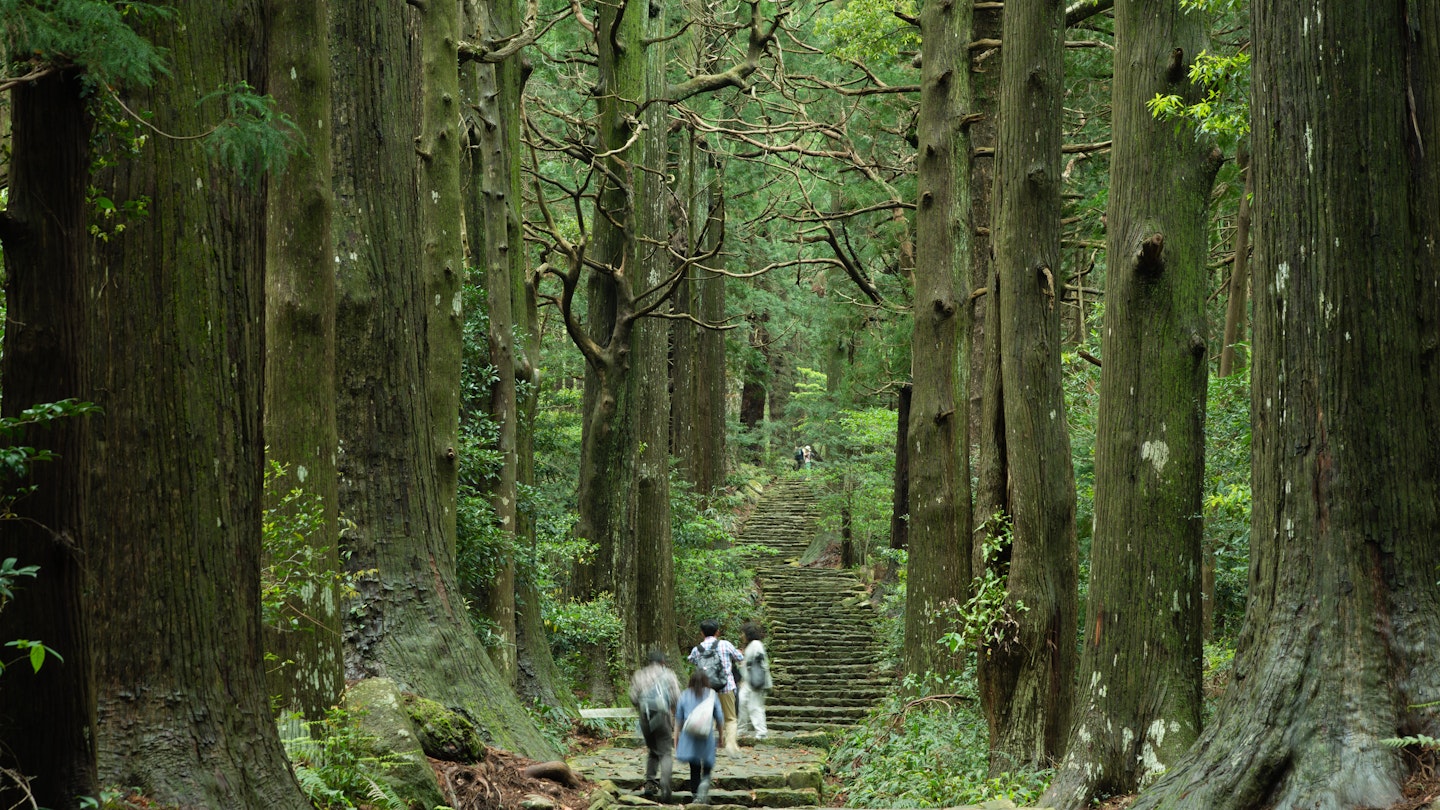At the heart of Japan lies Wakayama-ken, a prefecture rich in spirit, history, and natural beauty. Here, lesser-tread paths lead to rugged hiking trails, perfect coastal beaches, tranquil natural hot springs, and sacred pilgrimage routes.
To the north, visitors can experience feudal-era Japan in Wakayama City, as well as venture to the ancient monastic settlement of Kōya-san to spend the night in a Buddhist temple nestled in the mountains. Furthermore, the world-famous Kumano Kodō pilgrimage trail exemplifies the prefecture’s distinct charm, merging the serene with the sublime. Read on for tips on making the most of your trip to Wakayama.
Pilgrimage Routes
Weaving its way through the mountainous Kii Peninsula just south of Nara, the Kumano Kodō pilgrimage routes have been in use for over 1000 years. Historically, Japanese people believed that this wooded region was inhabited by Shinto deities called Kami. When Buddhism later gained popularity in Japan, these nature gods became gongen, manifestations of the Buddha or a Bodhisattva.
Today, visitors can follow the same routes that countless pilgrims traced in the 9th century. The trail offers no official start or end point, with hiking options varying from moderate rambles lasting a few hours to strenuous treks over several days. Along the way, you’ll encounter forests, temples, shrines, waterfalls, and some of Japan’s most revered ‘power spots.’
The focus of a pilgrimage here often includes visiting the shrines at Kumano Sanzan (three Grand Shrines). The individual shrines are known as Kumano Hongu Taisha, Kumano Hayatama Taisha, and Kumano Nachi Taisha, while the temple is called Nachisan Seiganto-ji Temple. The Nakahechi route, also known as the Imperial Route, is perhaps the most action-packed way to see the area and a popular choice among visitors. In 2004, the Sacred Sites and Pilgrimage Routes in the Kii Mountain Range were granted World Heritage status, marking the second pilgrimage route recognized by Unesco.
Coastal Charms
The Wakayama coast, sprawling along the Pacific Ocean, is a paradise for lovers of the sea and sand. The prefecture boasts pristine white beaches offering snorkeling, scuba diving, and whale watching opportunities. The waters are dotted with small islands awaiting exploration, including the four-part cluster in the north known as Tomogashima. Accessible by a 20-minute ferry ride from Wakayama City, the main island features ruins of an abandoned military fort along with numerous picnic and camping spots.
At the southern tip of the Kii Peninsula lies Kushimoto, a diver’s paradise with crystal-clear waters and coral reefs. Visitors can appreciate the underwater world via glass-bottom boat rides, while the nearby Shionomisaki Lighthouse, which houses a small museum, is worth exploring. Continuing south, the cape of Shiono-misaki offers stunning vistas, connected to Kii-Ōshima, a small island with attractive coastal cliffs.
Traveling along the coastline, visitors arrive at Shirahama, the leading beach resort in the region, featuring large hotels, amusement parks, and aquariums. Shirahama is especially popular during July and August, yet it also boasts a beautiful coastline appealing to nature-lovers. Notable sites include the 50-meter high Sandanbeki Rock cliffs and Engetsuto Island, a perfect spot for sunset appreciation.
Delicious Delicacies
When it comes to Wakayama’s culinary offerings, seafood reigns supreme. The prefecture handles the highest volume of fresh tuna in Japan, with staples such as sashimi, panko-breaded deep-fried tuna, and nabe, a hotpot filled with local grouper. Kuroshio Market hosts tuna filleting shows three times a day (check local listings for exact timings), alongside numerous fresh seafood restaurants offering local dishes.
In Nachikatsuura, Yakiniku Dining Kazu invites visitors to sample tender Kumanogyu beef cooked over a barbecue, attracting regulars even from Osaka. Often referred to as ‘The Fruit Kingdom,’ Wakayama enjoys fertile soils and a temperate climate, producing strawberries, persimmons, peaches, mandarins, and citrus fruits. These fruits are creatively transformed into jellies, marmalades, and sauces like ponzu that can be purchased at local markets and souvenir shops.
Festivals
Wakayama-ken hosts a variety of unique festivals throughout the year, offering a glimpse into local culture and history. The Nachi-no-Hi Matsuri (Fire Festival) takes place in July at the Kumano Nachi Taisha Grand Shrine, where participants carry large flaming torches down paths to a sacred waterfall in a special Shinto ritual. Additionally, the Shirahama sand art festival in spring features contestants creating intricate three-dimensional sculptures right on the beach.
Getting Around
Wakayama is well-connected through various trains and buses, with Wakayama Station serving as a central hub for transportation across the prefecture. Train passes can provide discounts for international visitors, and it’s advisable to keep an eye out for the best travel plans. Additionally, the Koyasan & Kumano Access Bus offers unlimited rides connecting the Koyasan area to the Kumano Sanzan heritage sites.
Cycling is another popular mode of transport, given the scenic coastal routes and views available. A flat 45-minute ride from Wakayama City center to Marina City offers a delightful way to experience the area. Bicycle rental services, both battery-assisted and conventional, are typically available near train stations and information centers, providing recommendations for good cycling routes. For more information on navigating the prefecture, visit the official Visit Wakayama website.





